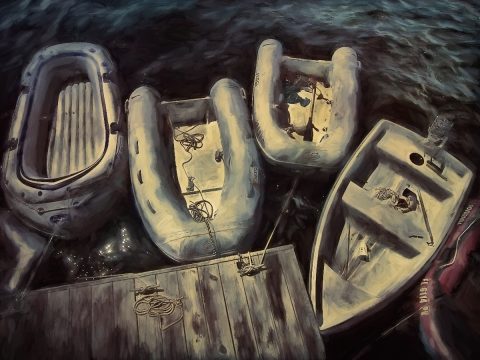Where did the inspiration for this story start?
My grandmother is aging. She is a wonderful, selfless woman, and I intended this story, at first, to be kind of an homage to her—a recognition of her lived experience. It seems that aging (whether from child to teenager, teenager to adult, or adult to older adult) is about searching for your identity—where you fit, or how you fit, into each new phase and role and set of expectations people have for you. I wanted this story to be a kind of “I see you; I love you” moment for my grandmother. Later, I realized that one person’s identity doesn’t shift without other people’s identities changing, especially in a group like a family, where the bonds are so strong. The story shifted from an homage to an exploration of the power of love to help us understand each other as we grow and change.
Tell me about the decision to tell this story in a collective ‘we’ voice.
I think the point-of-view choices I made came from the characters—I knew I wanted to write about teenage girls who are grappling with the idea that their grandmother is aging. The more I thought about how teenage girls communicate with each other and engage with the world around them, the first-person plural point-of-view seemed natural. When I was teaching high school (and when I was a teenager), I noticed that the girls put a lot of emphasis on who belonged to which group; they patrolled each other’s actions to make sure that the group boundaries remained intact. For this particular story, the girls considered their grandmother a part of their group, and then she started acting in ways that didn’t make sense in the world the group had created.
It seems to me that the characters of a story will guide you to the point of view that makes sense for the moment of their story. Writing is a lot about listening and empathy for me—listening to the characters (and feeling with them) leads me to the most organic storytelling.
You like to incorporate social media into your stories. Why? What’s the appeal and fascination with these platforms and your fiction?
I think the inclusion of social media comes from the characters, too. Social media is a huge part of the lives of a lot of teenagers. The girls’ voice would seem inauthentic to me without Twitter and Snapchat, because those are the tools their created group uses to understand themselves and others. Also, I think that including social media allows me to be more playful with language—the ways people write on the internet are often more inventive (and funnier) than the ways people write in other situations. Including social media seems to allow me to infuse a bit of levity in a serious situation (like watching a grandmother age.)
What’s been your favorite part about the Kathy Fish Fellowship so far? What do you hope to learn/gain in the next few months?
The Kathy Fish Fellowship has been a great learning experience for me. I’ve loved the opportunity to connect with other writers, and the feedback I’ve received has been instrumental in helping me to create vivid flash fiction. In the next few months, I’m looking forward to the workshop process—having the opportunity to discuss fiction and to toss ideas back and forth really helps me engage with my work in ways I wouldn’t have previously considered. I love collaborating with such a great group!




 The core workshop of SmokeLong Fitness is all in writing, so you can take part from anywhere at anytime. We are excited about creating a supportive, consistent and structured environment for flash writers to work on their craft in a community. We are thrilled and proud to say that our workshop participants have won, placed, or been listed in every major flash competition. Community works.
The core workshop of SmokeLong Fitness is all in writing, so you can take part from anywhere at anytime. We are excited about creating a supportive, consistent and structured environment for flash writers to work on their craft in a community. We are thrilled and proud to say that our workshop participants have won, placed, or been listed in every major flash competition. Community works.